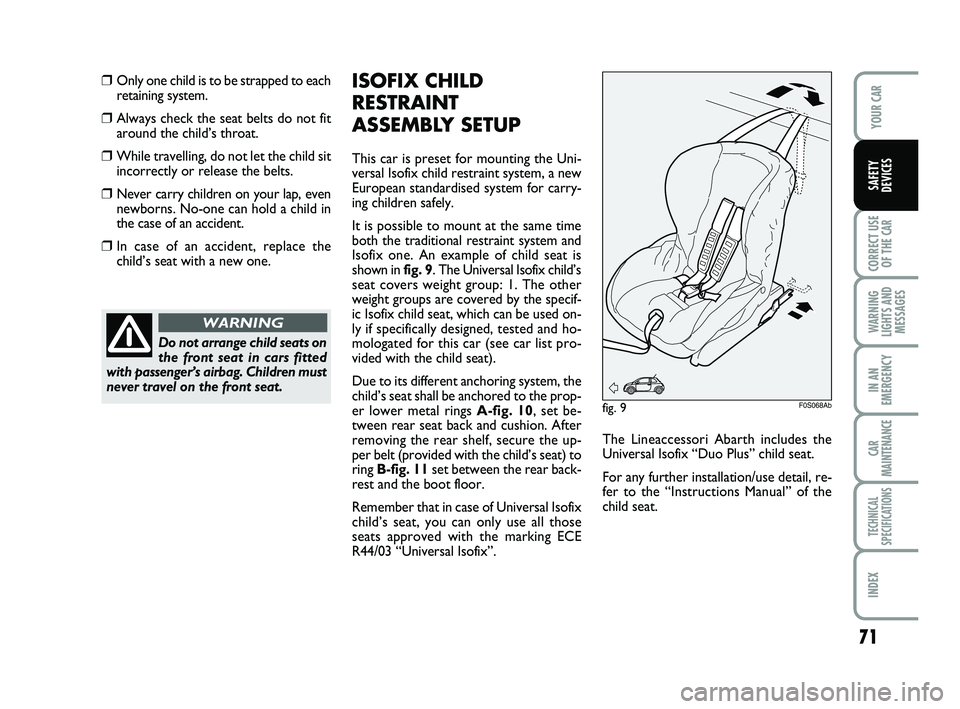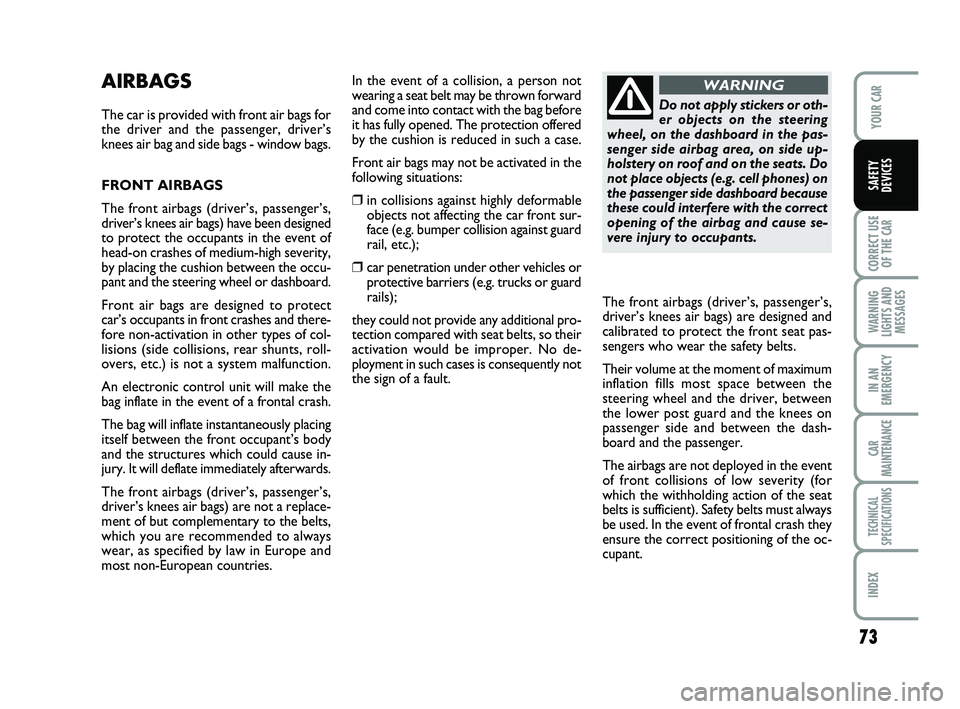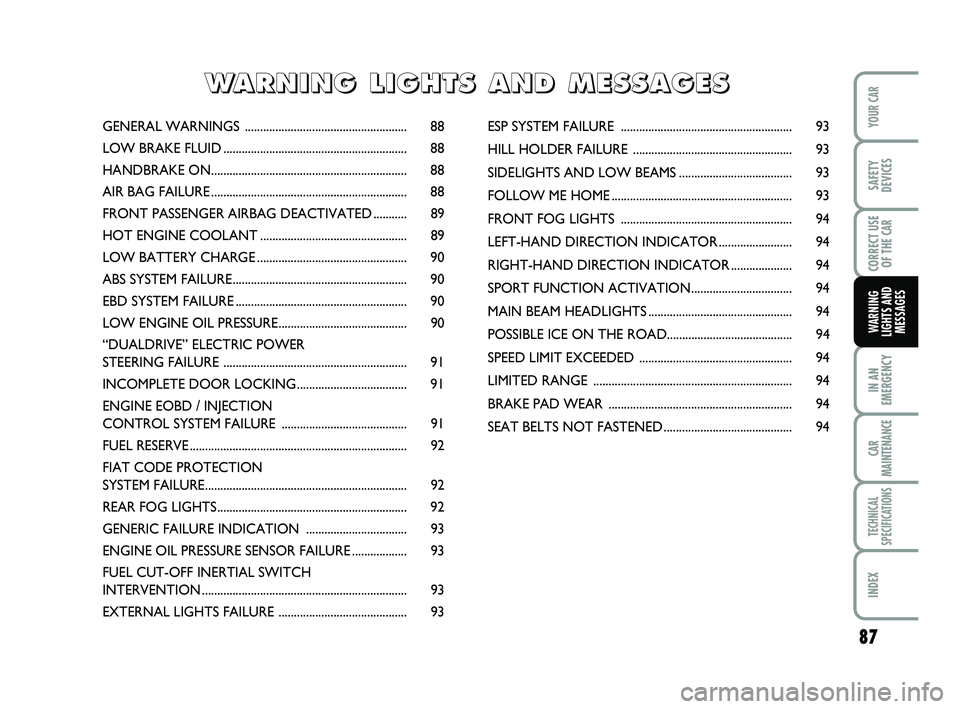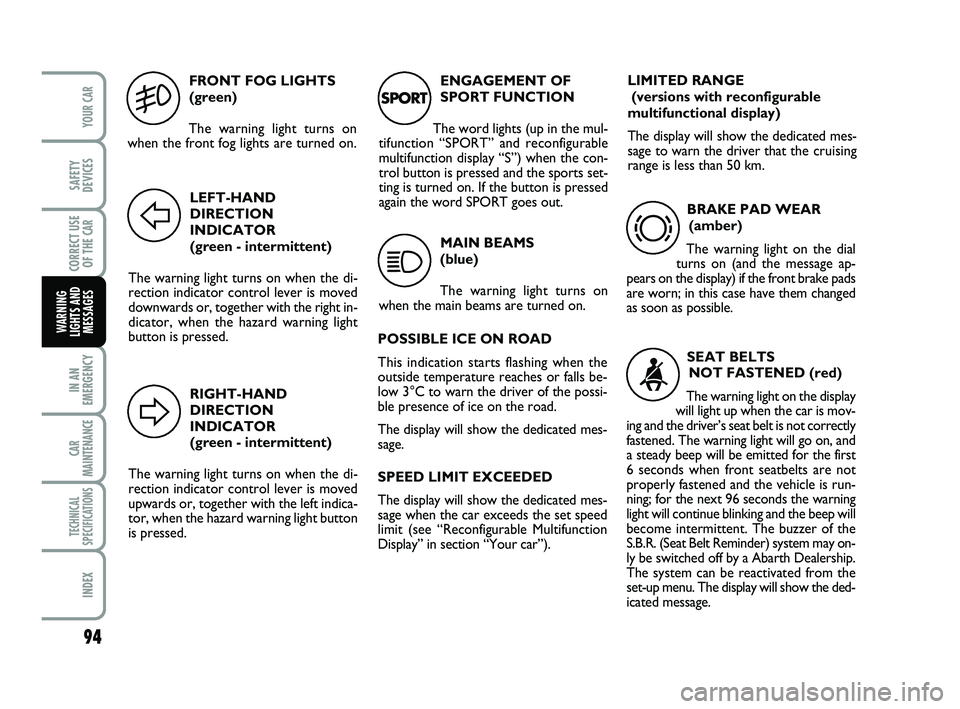belt Abarth 500 2008 Owner handbook (in English)
[x] Cancel search | Manufacturer: ABARTH, Model Year: 2008, Model line: 500, Model: Abarth 500 2008Pages: 170, PDF Size: 3.04 MB
Page 70 of 170

69
CORRECT USE
OF THE
CAR
WARNING
LIGHTS AND
MESSAGES
IN AN
EMERGENCY
CAR
MAINTENANCE
TECHNICAL
SPECIFICATIONS
INDEX
YOUR CAR
SAFETY
DEVICES
GROUP 3
For children from 22 kg to 36 kg the size
of the child’s chest no longer requires a
support to space the child’s back from the
seat back.
Fig. 8shows proper child seat position-
ing on the rear seat.
Children taller than 1.50 m can wear seat
belts like adults.
fig. 8F0S067Ab
The figures are indicative for
assembly purposes only. Re-
fer to the instructions supplied with
the child restraint.
WARNING
GROUP 2
Children from 15 to 25 kg may use the car
seat belts directly fig. 7.
The child seat is only needed to position
the child correctly with respect to the
belts so that the diagonal section crosses
the child’s chest and never the neck and is
snug on the hips not the abdomen.
fig. 7F0S066Ab
The figures are indicative for
assembly purposes only. Re-
fer to the instructions supplied with
the child restraint.
WARNING
063-078 ABARTH 500 GB 29-04-2009 9:42 Pagina 69
Page 71 of 170

70
CORRECT USE
OF THE
CAR
WARNING
LIGHTS AND
MESSAGES
IN AN
EMERGENCY
CAR
MAINTENANCE
TECHNICAL
SPECIFICATIONS
INDEX
YOUR CAR
SAFETY
DEVICES
PASSENGER SEAT COMPLIANCE WITH REGULATIONS ON
CHILD’S SEAT USE
The Abarth complies with the new European Directive 2000/3/EC which gov-
erns the arrangement possibilities for child restraints on the various seats of the car
as shown in the following table:
Passenger PassengerGroup Weight ranges front rear
Group 0, 0+ up to 13 kg U U
Group 1 9-18 kg U U
Group 2 15-25 kg U U
Group 3 22-36 kg U U
Key:
U = suitable for child restraint systems of the “Universal” category, according to Eu-
ropean Standard ECE-R44 for the specified “Groups”.Below is a summary of the rules of safety
to be followed for carrying children:
❒Install the child seats on the rear seat,
which is the most protected position in
the event of an accident.
❒If the passenger’s air bag is deactivated,
always check the amber warning light
“on the instrument panel to make
sure that it has actually been deactivat-
ed.
❒Carefully follow the instructions sup-
plied with the child restraint system
which are mandatory by law. Keep the
instructions in the car along with the
other papers and this handbook. Do
not use child seats without instructions.
❒Always check the seat belt is well fas-
tened by pulling the belt.
063-078 ABARTH 500 GB 29-04-2009 9:42 Pagina 70
Page 72 of 170

71
CORRECT USE
OF THE
CAR
WARNING
LIGHTS AND
MESSAGES
IN AN
EMERGENCY
CAR
MAINTENANCE
TECHNICAL
SPECIFICATIONS
INDEX
YOUR CAR
SAFETY
DEVICES
❒Only one child is to be strapped to each
retaining system.
❒Always check the seat belts do not fit
around the child’s throat.
❒While travelling, do not let the child sit
incorrectly or release the belts.
❒Never carry children on your lap, even
newborns. No-one can hold a child in
the case of an accident.
❒In case of an accident, replace the
child’s seat with a new one.
Do not arrange child seats on
the front seat in cars fitted
with passenger’s airbag. Children must
never travel on the front seat.
WARNING
The Lineaccessori Abarth includes the
Universal Isofix “Duo Plus” child seat.
For any further installation/use detail, re-
fer to the “Instructions Manual” of the
child seat.
ISOFIX CHILD
RESTRAINT
ASSEMBLY SETUP
This car is preset for mounting the Uni-
versal Isofix child restraint system, a new
European standardised system for carry-
ing children safely.
It is possible to mount at the same time
both the traditional restraint system and
Isofix one. An example of child seat is
shown in fig. 9. The Universal Isofix child’s
seat covers weight group: 1. The other
weight groups are covered by the specif-
ic Isofix child seat, which can be used on-
ly if specifically designed, tested and ho-
mologated for this car (see car list pro-
vided with the child seat).
Due to its different anchoring system, the
child’s seat shall be anchored to the prop-
er lower metal rings A-fig. 10, set be-
tween rear seat back and cushion. After
removing the rear shelf, secure the up-
per belt (provided with the child’s seat) to
ring B-fig. 11set between the rear back-
rest and the boot floor.
Remember that in case of Universal Isofix
child’s seat, you can only use all those
seats approved with the marking ECE
R44/03 “Universal Isofix”.
fig. 9F0S068Ab
063-078 ABARTH 500 GB 29-04-2009 9:42 Pagina 71
Page 74 of 170

73
CORRECT USE
OF THE
CAR
WARNING
LIGHTS AND
MESSAGES
IN AN
EMERGENCY
CAR
MAINTENANCE
TECHNICAL
SPECIFICATIONS
INDEX
YOUR CAR
SAFETY
DEVICES
AIRBAGS
The car is provided with front air bags for
the driver and the passenger, driver’s
knees air bag and side bags - window bags.
FRONT AIRBAGS
The front airbags (driver’s, passenger’s,
driver’s knees air bags) have been designed
to protect the occupants in the event of
head-on crashes of medium-high severity,
by placing the cushion between the occu-
pant and the steering wheel or dashboard.
Front air bags are designed to protect
car’s occupants in front crashes and there-
fore non-activation in other types of col-
lisions (side collisions, rear shunts, roll-
overs, etc.) is not a system malfunction.
An electronic control unit will make the
bag inflate in the event of a frontal crash.
The bag will inflate instantaneously placing
itself between the front occupant’s body
and the structures which could cause in-
jury. It will deflate immediately afterwards.
The front airbags (driver’s, passenger’s,
driver’s knees air bags) are not a replace-
ment of but complementary to the belts,
which you are recommended to always
wear, as specified by law in Europe and
most non-European countries.In the event of a collision, a person not
wearing a seat belt may be thrown forward
and come into contact with the bag before
it has fully opened. The protection offered
by the cushion is reduced in such a case.
Front air bags may not be activated in the
following situations:
❒in collisions against highly deformable
objects not affecting the car front sur-
face (e.g. bumper collision against guard
rail, etc.);
❒car penetration under other vehicles or
protective barriers (e.g. trucks or guard
rails);
they could not provide any additional pro-
tection compared with seat belts, so their
activation would be improper. No de-
ployment in such cases is consequently not
the sign of a fault.
Do not apply stickers or oth-
er objects on the steering
wheel, on the dashboard in the pas-
senger side airbag area, on side up-
holstery on roof and on the seats. Do
not place objects (e.g. cell phones) on
the passenger side dashboard because
these could interfere with the correct
opening of the airbag and cause se-
vere injury to occupants.
WARNING
The front airbags (driver’s, passenger’s,
driver’s knees air bags) are designed and
calibrated to protect the front seat pas-
sengers who wear the safety belts.
Their volume at the moment of maximum
inflation fills most space between the
steering wheel and the driver, between
the lower post guard and the knees on
passenger side and between the dash-
board and the passenger.
The airbags are not deployed in the event
of front collisions of low severity (for
which the withholding action of the seat
belts is sufficient). Safety belts must always
be used. In the event of frontal crash they
ensure the correct positioning of the oc-
cupant.
063-078 ABARTH 500 GB 29-04-2009 9:42 Pagina 73
Page 79 of 170

78
CORRECT USE
OF THE
CAR
WARNING
LIGHTS AND
MESSAGES
IN AN
EMERGENCY
CAR
MAINTENANCE
TECHNICAL
SPECIFICATIONS
INDEX
YOUR CAR
SAFETY
DEVICES
Do not wash the seats with
pressurized water or steam
(manually or at the automatic wash-
ing stations).
WARNING
Front air bag activation if
foreseen in case of more se-
vere collisions compared with pre-
tensioner activation. For collisions in
the range between the two activation
thresholds, the fact that only the pre-
tensioners activate is normal.
WARNING
Do not hook rigid objects to
cloth hangers and to the
support handles.
WARNING
The air bag does not replace
the safety belts, it increases
their effectiveness. Furthermore, since
front airbags are not deployed in low
speed collisions, side collisions, rear-
end shunts or roll-overs, the occu-
pants are only protected by the seat
belts which must be fastened at all
times.
WARNING
Rotating the key on MAR,
the warning light “turns on,
blinking for a few seconds, to remind
that the passenger air bag will acti-
vate in the event of a collision, then
it turns off.
WARNING
063-078 ABARTH 500 GB 29-04-2009 9:42 Pagina 78
Page 88 of 170

87
IN AN
EMERGENCY
CAR
MAINTENANCE
TECHNICAL
SPECIFICATIONS
INDEX
YOUR CAR
SAFETY
DEVICES
CORRECT USE
OF THE
CAR
WARNING
LIGHTS AND
MESSAGES
GENERAL WARNINGS ..................................................... 88
LOW BRAKE FLUID............................................................ 88
HANDBRAKE ON................................................................ 88
AIR BAG FAILURE................................................................ 88
FRONT PASSENGER AIRBAG DEACTIVATED........... 89
HOT ENGINE COOLANT................................................ 89
LOW BATTERY CHARGE................................................. 90
ABS SYSTEM FAILURE......................................................... 90
EBD SYSTEM FAILURE........................................................ 90
LOW ENGINE OIL PRESSURE.......................................... 90
“DUALDRIVE” ELECTRIC POWER
STEERING FAILURE ............................................................ 91
INCOMPLETE DOOR LOCKING.................................... 91
ENGINE EOBD / INJECTION
CONTROL SYSTEM FAILURE ......................................... 91
FUEL RESERVE....................................................................... 92
FIAT CODE PROTECTION
SYSTEM FAILURE.................................................................. 92
REAR FOG LIGHTS.............................................................. 92
GENERIC FAILURE INDICATION ................................. 93
ENGINE OIL PRESSURE SENSOR FAILURE.................. 93
FUEL CUT-OFF INERTIAL SWITCH
INTERVENTION................................................................... 93
EXTERNAL LIGHTS FAILURE .......................................... 93ESP SYSTEM FAILURE ........................................................ 93
HILL HOLDER FAILURE .................................................... 93
SIDELIGHTS AND LOW BEAMS..................................... 93
FOLLOW ME HOME........................................................... 93
FRONT FOG LIGHTS ........................................................ 94
LEFT-HAND DIRECTION INDICATOR........................ 94
RIGHT-HAND DIRECTION INDICATOR.................... 94
SPORT FUNCTION ACTIVATION................................. 94
MAIN BEAM HEADLIGHTS............................................... 94
POSSIBLE ICE ON THE ROAD.........................................94
SPEED LIMIT EXCEEDED .................................................. 94
LIMITED RANGE ................................................................. 94
BRAKE PAD WEAR ............................................................ 94
SEAT BELTS NOT FASTENED.......................................... 94
W
W W W
A A A A
R R R R
N N N N
I I I I
N N N N
G G G G
L L L L
I I I I
G G G G
H H H H
T T T T
S S S S
A A A A
N N N N
D D D D
M M M M
E E E E
S S S S
S S S S
A A A A
G G G G
E EE
E
S S S S
087-094 ABARTH 500 GB 29-04-2009 9:42 Pagina 87
Page 95 of 170

94
IN AN
EMERGENCY
CAR
MAINTENANCE
TECHNICAL
SPECIFICATIONS
INDEX
YOUR CAR
SAFETY
DEVICES
CORRECT USE
OF THE
CAR
WARNING
LIGHTS AND
MESSAGES
FRONT FOG LIGHTS
(green)
The warning light turns on
when the front fog lights are turned on.
5
LEFT-HAND
DIRECTION
INDICATOR
(green - intermittent)
The warning light turns on when the di-
rection indicator control lever is moved
downwards or, together with the right in-
dicator, when the hazard warning light
button is pressed.
F
RIGHT-HAND
DIRECTION
INDICATOR
(green - intermittent)
The warning light turns on when the di-
rection indicator control lever is moved
upwards or, together with the left indica-
tor, when the hazard warning light button
is pressed.
D
ENGAGEMENT OF
SPORT FUNCTION
The word lights (up in the mul-
tifunction “SPORT” and reconfigurable
multifunction display “S”) when the con-
trol button is pressed and the sports set-
ting is turned on. If the button is pressed
again the word SPORT goes out.
SPORT
MAIN BEAMS
(blue)
The warning light turns on
when the main beams are turned on.
1
LIMITED RANGE
(versions with reconfigurable
multifunctional display)
The display will show the dedicated mes-
sage to warn the driver that the cruising
range is less than 50 km.
POSSIBLE ICE ON ROAD
This indication starts flashing when the
outside temperature reaches or falls be-
low 3°C to warn the driver of the possi-
ble presence of ice on the road.
The display will show the dedicated mes-
sage.
SPEED LIMIT EXCEEDED
The display will show the dedicated mes-
sage when the car exceeds the set speed
limit (see “Reconfigurable Multifunction
Display” in section “Your car”).BRAKE PAD WEAR
(amber)
The warning light on the dial
turns on (and the message ap-
pears on the display) if the front brake pads
are worn; in this case have them changed
as soon as possible.
d
SEAT BELTS
NOT FASTENED (red)
The warning light on the display
will light up when the car is mov-
ing and the driver’s seat belt is not correctly
fastened. The warning light will go on, and
a steady beep will be emitted for the first
6 seconds when front seatbelts are not
properly fastened and the vehicle is run-
ning; for the next 96 seconds the warning
light will continue blinking and the beep will
become intermittent. The buzzer of the
S.B.R. (Seat Belt Reminder) system may on-
ly be switched off by a Abarth Dealership.
The system can be reactivated from the
set-up menu. The display will show the ded-
icated message.
<
087-094 ABARTH 500 GB 29-04-2009 9:42 Pagina 94
Page 126 of 170

125
WARNING
LIGHTS AND
MESSAGES
TECHNICAL
SPECIFICATIONS
INDEX
YOUR CAR
SAFETY
DEVICES
CORRECT USE
OF THE CAR
IN AN
EMERGENCY
CAR
MAINTENANCE
SERVICE SCHEDULE
Service coupons shall be performed every 30,000 km
Thousands of kilometres
Check tyre conditions/wear and adjust pressure
if required
Check light system operation (headlights, direction indicators,
hazard lights, passenger compartment lights, boot lights,
instrument panel warning lights, etc.)
Check the operation of the windscreen wiper/washer system,
adjust the sprayers
Check the position and wear of the windscreen and
rear window wiper blades
Check front disc brake pad condition and wear and
operation of pad wear signalling
visually inspect the conditions of: bodywork, underbody
protection, pipes and hoses
(exhaust - fuel - brakes), rubber parts
(boots, sleeves, bushes, etc.)
Check cleanness of locks, bonnet and boot and lever
cleanness and lubrication
Check tension and if necessary adjust the accessory
drive belts
Visually inspect the accessory drive belt conditions
Replace accessory drive belts
Check and adjust handbrake lever stroke30 60 90 120 150 180
●●●●● ●
●●●●● ●
●●●●● ●
●●●●● ●
●●●●● ●
●●●●● ●
●●●●● ●
●●
●●
●
●●●●● ●
123-140 ABARTH 500 GB 29-04-2009 9:44 Pagina 125
Page 127 of 170

30 60 90 120 150 180
●●●●● ●
●●●●● ●
●●●●● ●
●●
●
●●●●● ●
●●●●● ●
●●
●●●●● ●
●●●
●●●●● ●
●●●●● ●
126
WARNING
LIGHTS AND
MESSAGES
TECHNICAL
SPECIFICATIONS
INDEX
YOUR CAR
SAFETY
DEVICES
CORRECT USE
OF THE CAR
IN AN
EMERGENCY
CAR
MAINTENANCE
Thousands of kilometres
Check rear disk brake pad conditions and wear
Replace the air filter cartridge
Top up fluids (engine coolant,
brakes, windscreen washer, battery, etc.)
Check the conditions of the distribution control toothed belt
Replace the distribution control toothed belt (*)
Replace the spark plugs (❍)
Check engine control system operation
(through diagnosis socket)
Check the mechanical gearbox oil level
Change engine oil and replace oil filter (or every 24 months)
Change brake fluid (or every 24 months)
Change the pollen filter (or anyway every year)
Check emissions at the exhaust
(*) Regardless of the km covered, the timing belt shall be replaced every 4 years for particularly demanding use (cold climates,
driving in the city, idling for a long time) or in any case every 5 years
If the car is mainly used for driving in the city, and in any case with an annual mileage of below 10,000 km, change
engine oil and filter every 12 months.
(❍) In order to ensure correct efficiency and avoid damaging the engine, it is necessary to:
- exclusively use certified spark plugs specific for the 1.4 TB BZ Abarth engines. All candles to be fitted must be
of the same type and same manufacturer (see recommendations reported in the “Engine” paragraph);
- strictly respect the candles’ Scheduled Maintenance Plan;
- it is recommended to apply to Abarth Dealership.
123-140 ABARTH 500 GB 29-04-2009 9:44 Pagina 126
Page 128 of 170

127
WARNING
LIGHTS AND
MESSAGES
TECHNICAL
SPECIFICATIONS
INDEX
YOUR CAR
SAFETY
DEVICES
CORRECT USE
OF THE CAR
IN AN
EMERGENCY
CAR
MAINTENANCE
DEMANDING
USE OF THE CAR
Should prevailing use of the car be under
one of the following specially heavy con-
ditions:
❒dusty roads;
❒short distances (less than 7-8 km) re-
peated and with external tempera-
tures below zero;
❒frequently idling engines or long dis-
tance low speed driving or in case of
a long term inactivity;
❒in cities;
perform the following inspections more
frequently than shown on the Service
Schedule:
❒check front/rear disc brake pad con-
dition and wear;
❒check cleanness of bonnet and boot
locks and lever cleanness and lubrica-
tion;
❒visually inspect the conditions of: en-
gine, gearbox, transmission, pipes and
hoses (exhaust - fuel - brakes), rubber
parts (boots, sleeves, bushes, etc.);
❒inspect the battery charge and fluid
level (electrolyte) (refer to the para-
graph “Battery - Inspection of the bat-
tery charge and of the electrolyte lev-
el” in this chapter);
❒visual check on various drive belt con-
ditions;
❒check and if necessary replace the
pollen filter; in particular it shall be re-
placed if a decrease in the air flow in-
to the passenger comportment is de-
tected;
❒check air cleaner and replace, if re-
quired.
REGULAR
INSPECTIONS
Every 1,000 km or before long journeys,
check and top up if required:
❒engine coolant fluid level;
❒brake fluid level;
❒windscreen washer fluid level;
❒tyre pressure and conditions;
❒operation of lights (headlights, direc-
tion indicators, hazard lights, etc.);
❒operation of the windscreen wiper/
washer system, position and wear of
the windscreen and rear window
wiper blades;
Every 3,000 km check the following and
top-up, if required: engine oil level.
You are recommended to use FL
Seleniaproducts, designed and produced
specifically for Abarth cars (see table “Ca-
pacities” in section “Technical specifica-
tions”).
123-140 ABARTH 500 GB 29-04-2009 9:44 Pagina 127